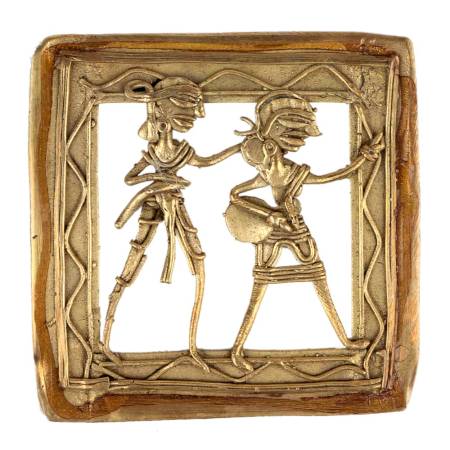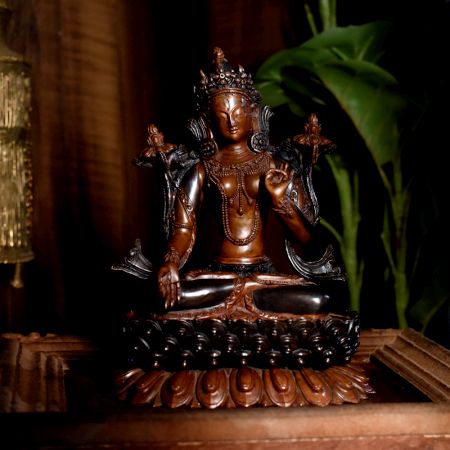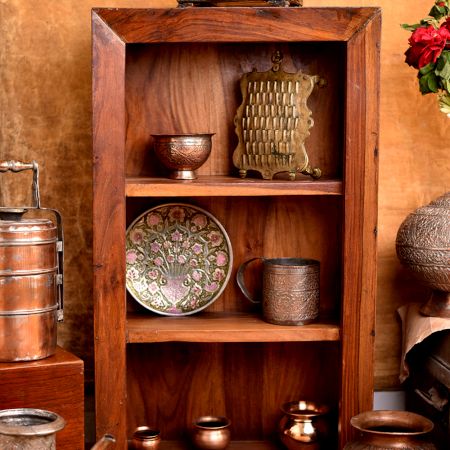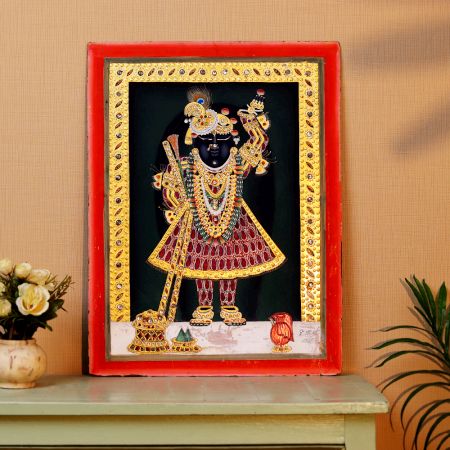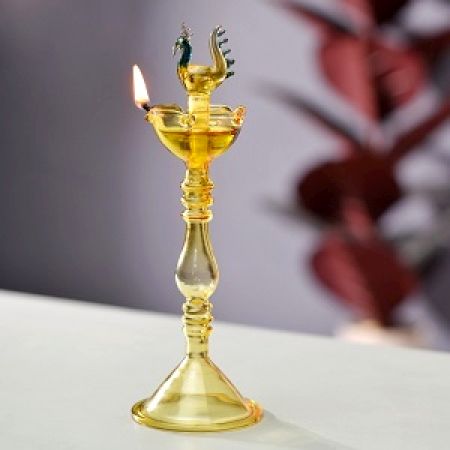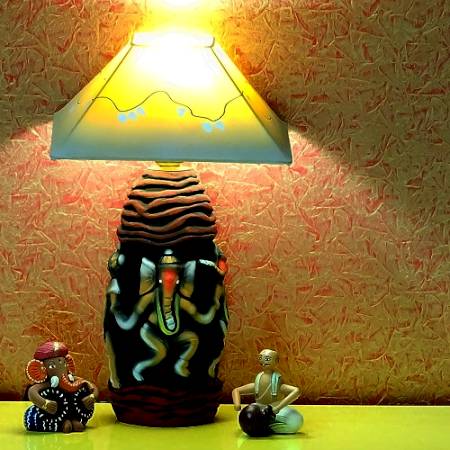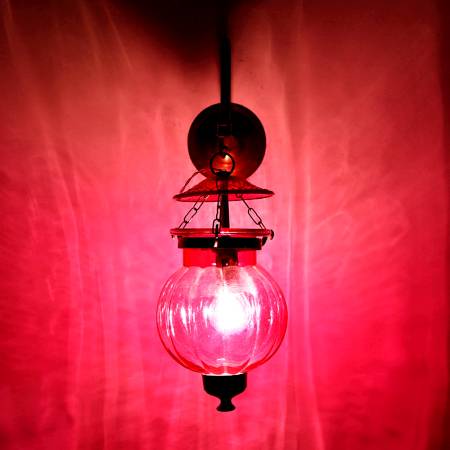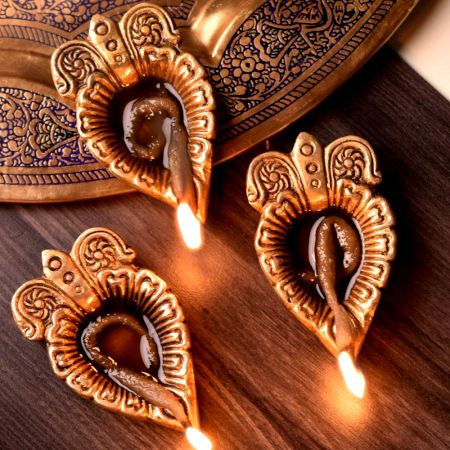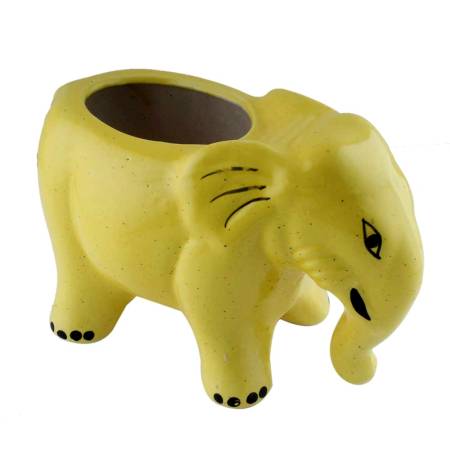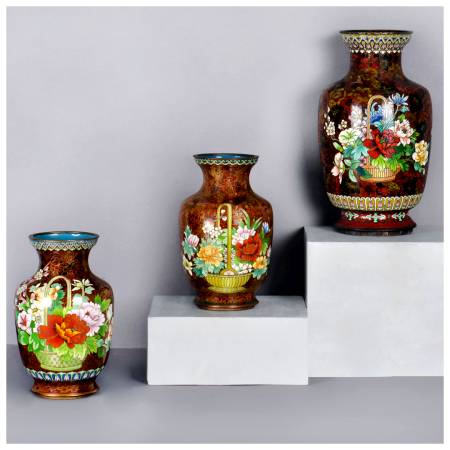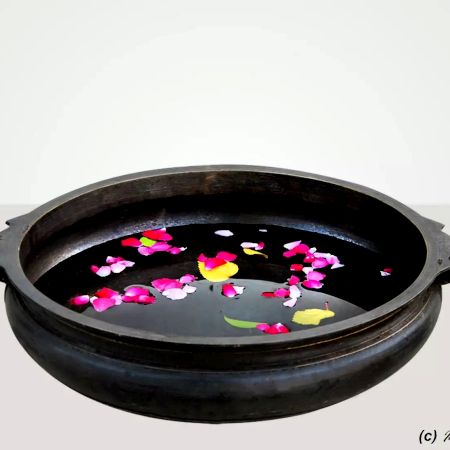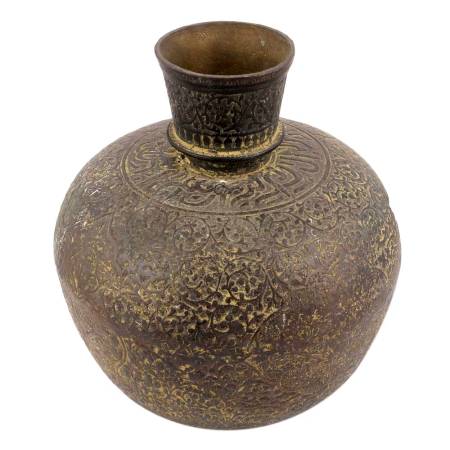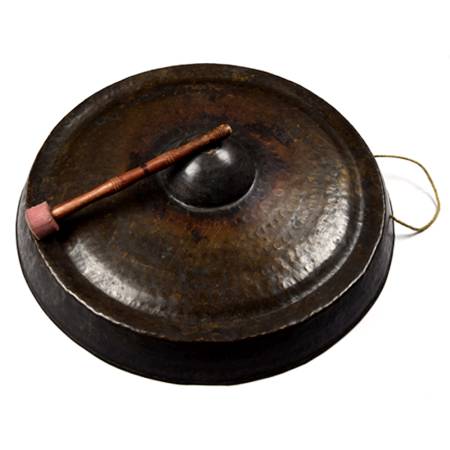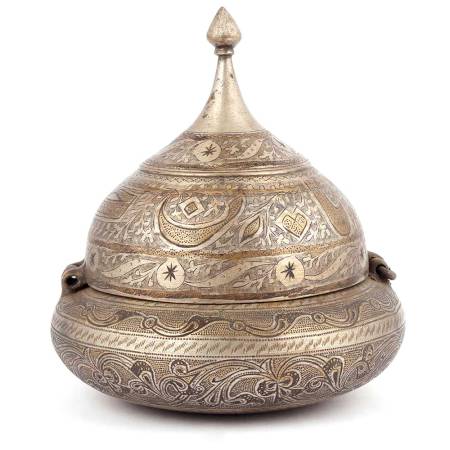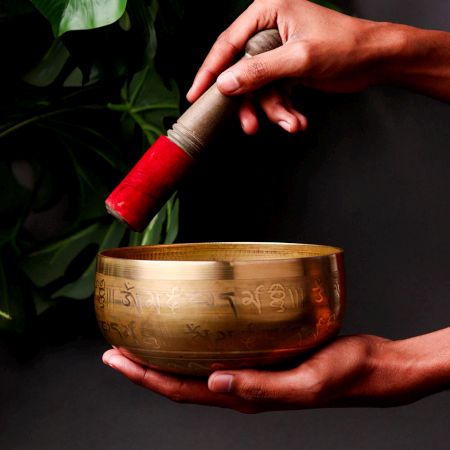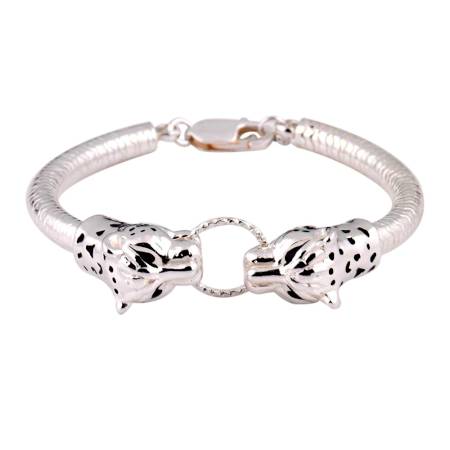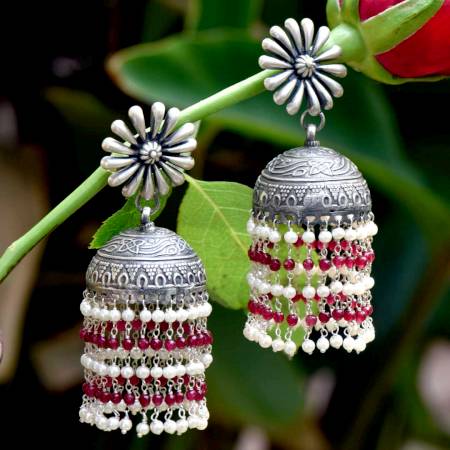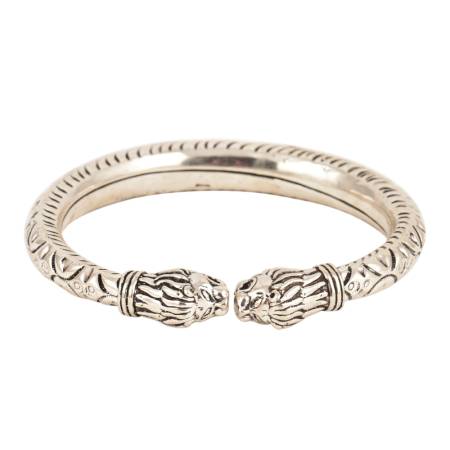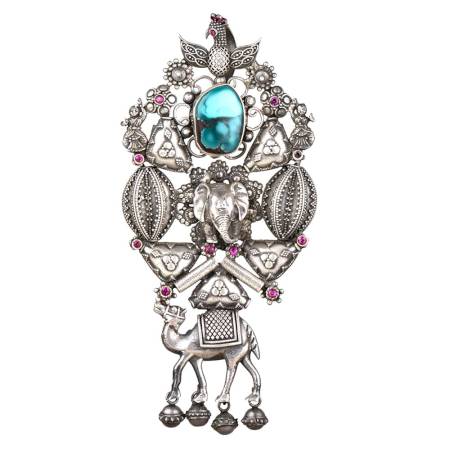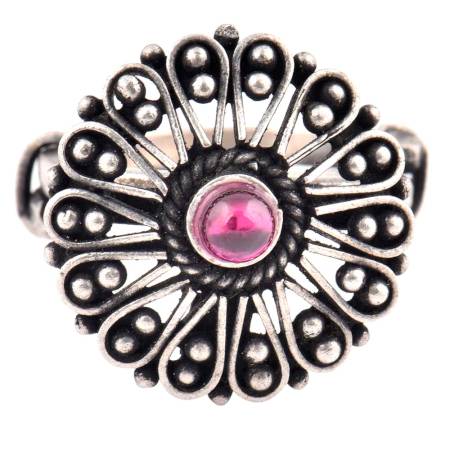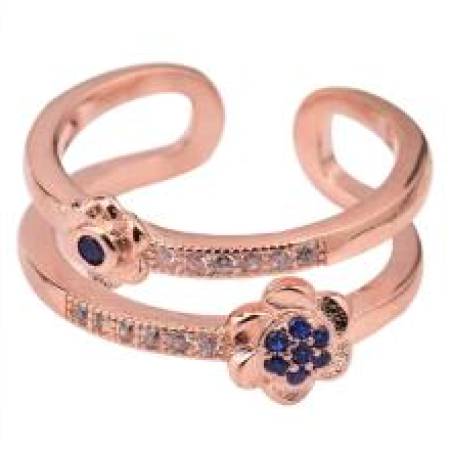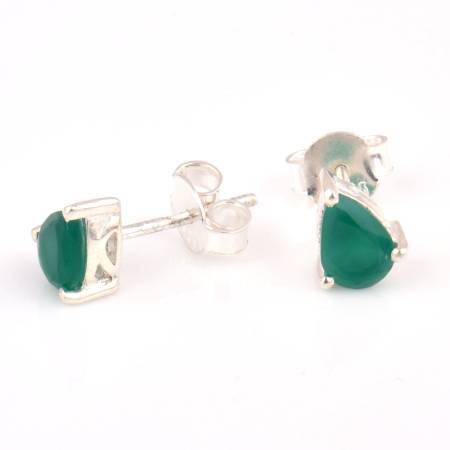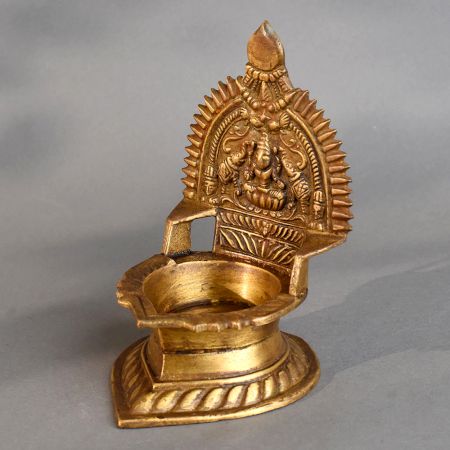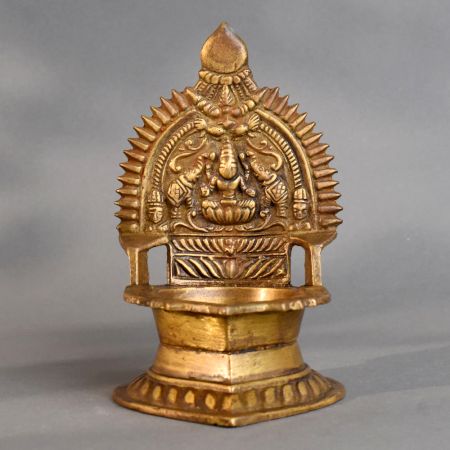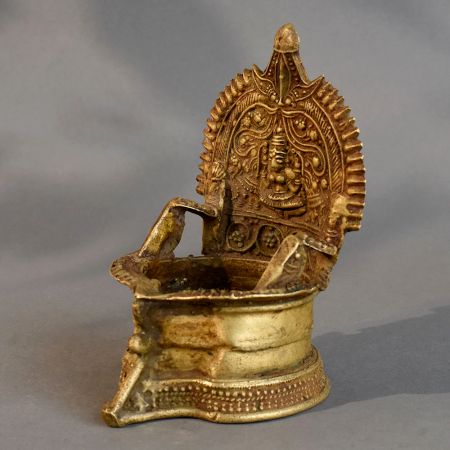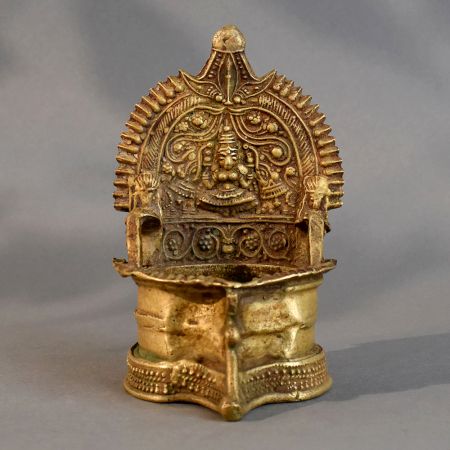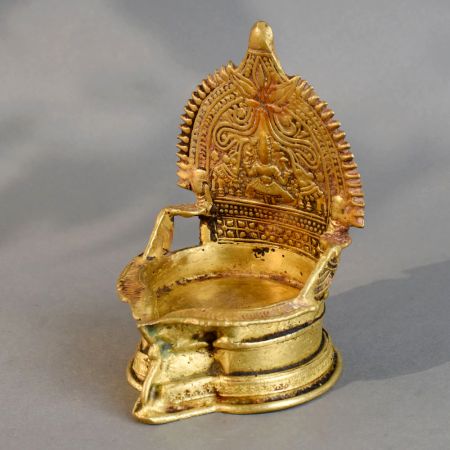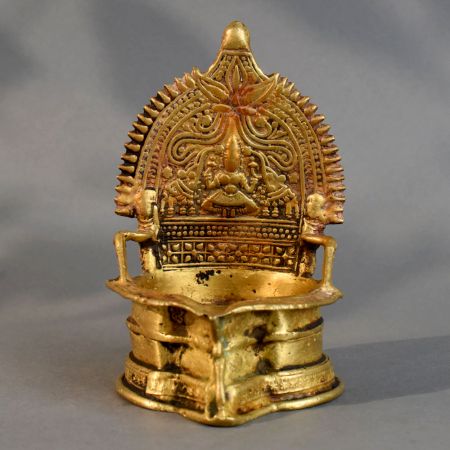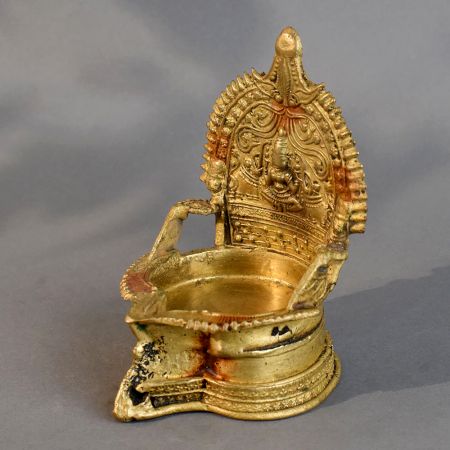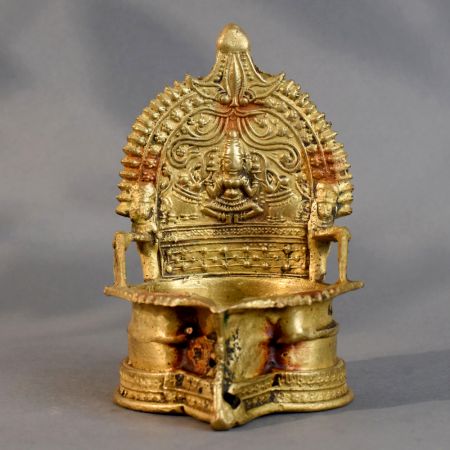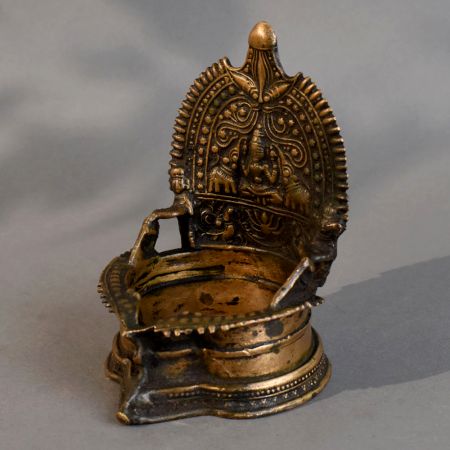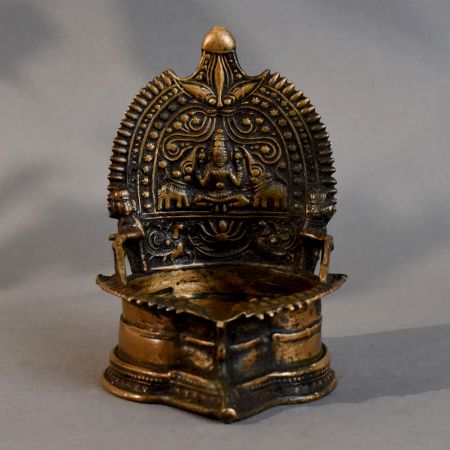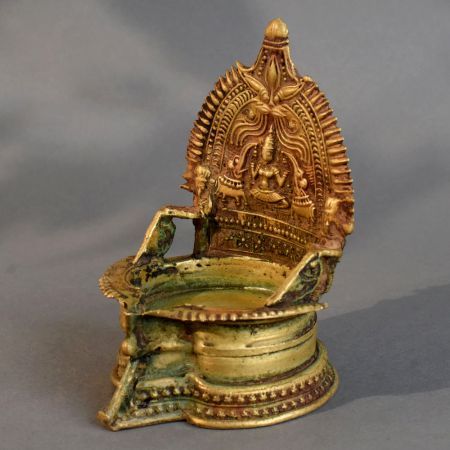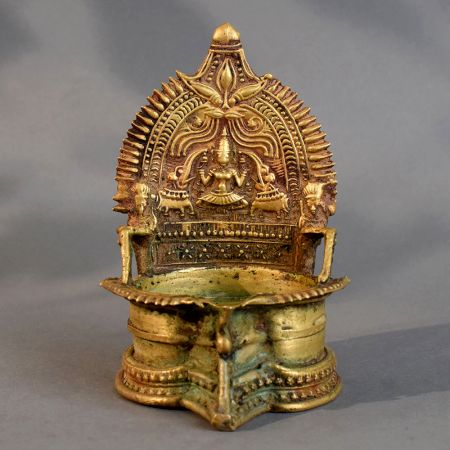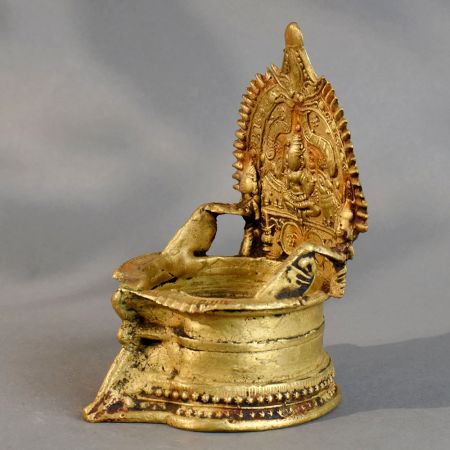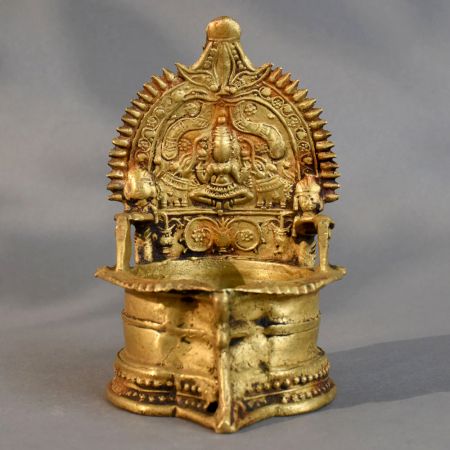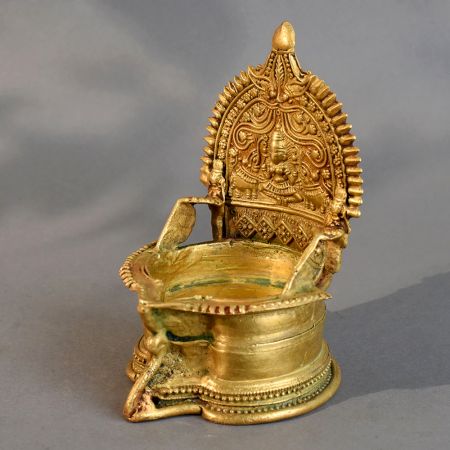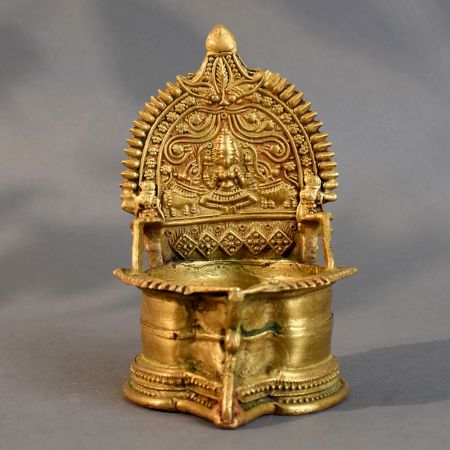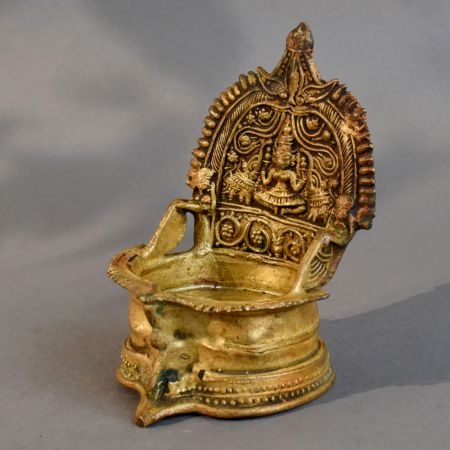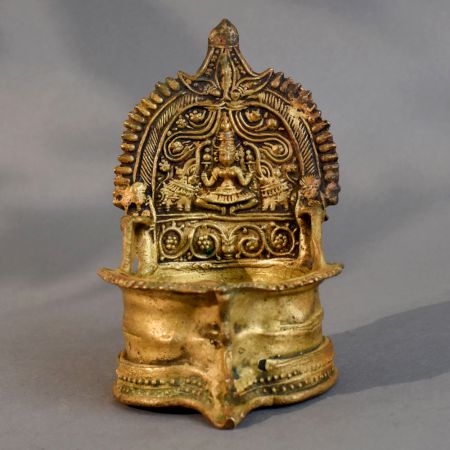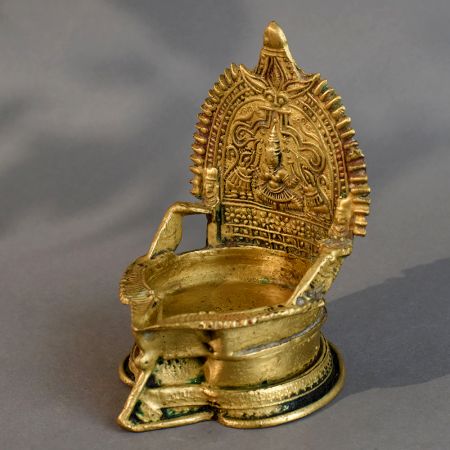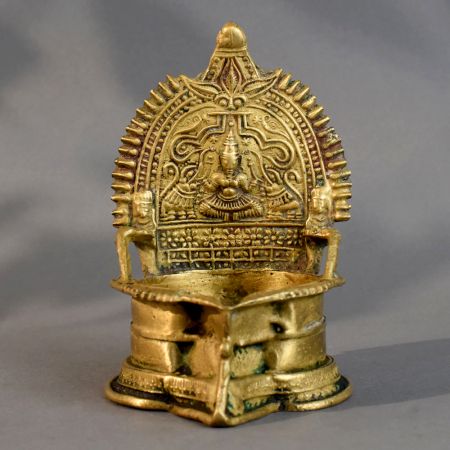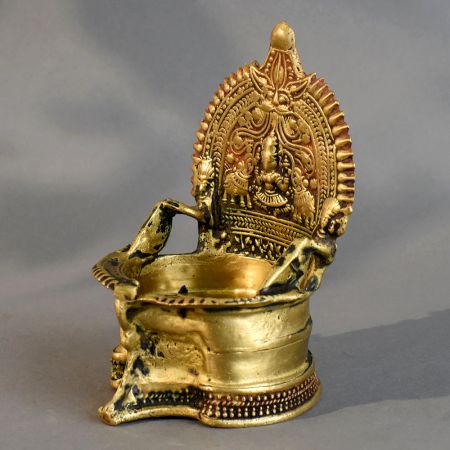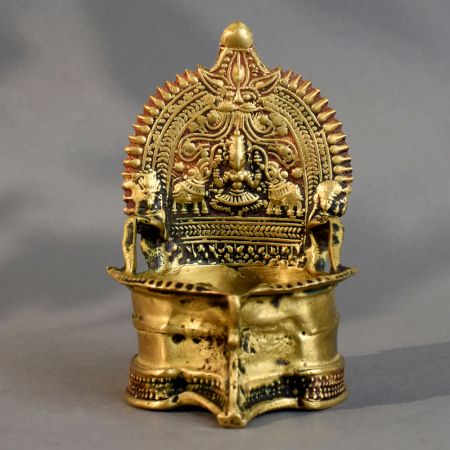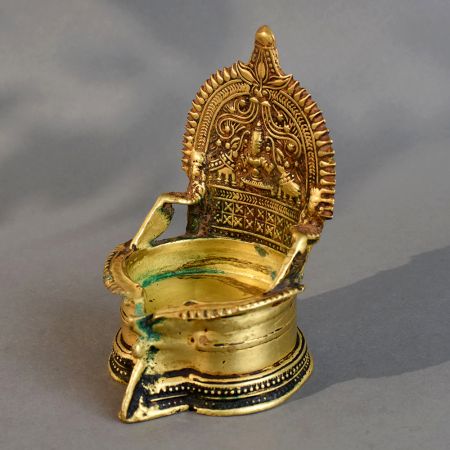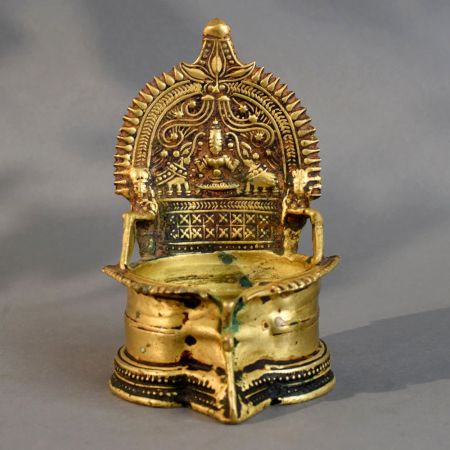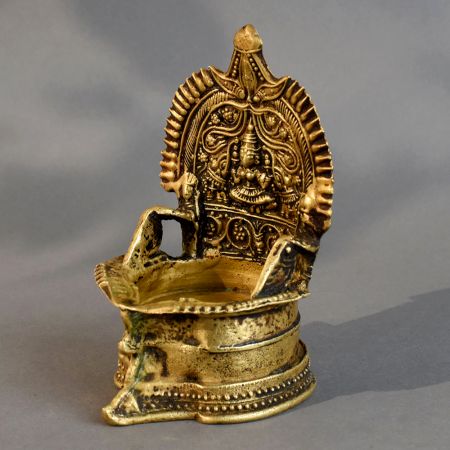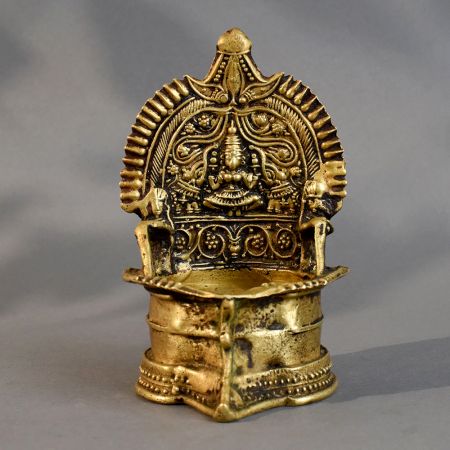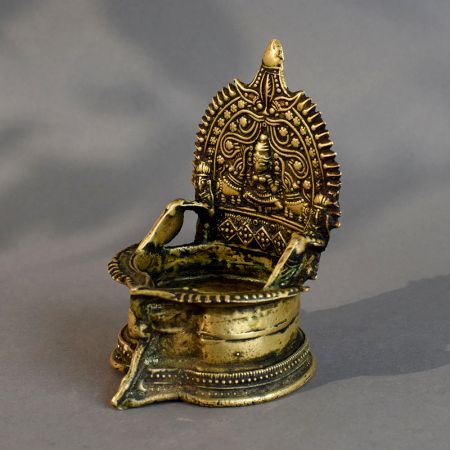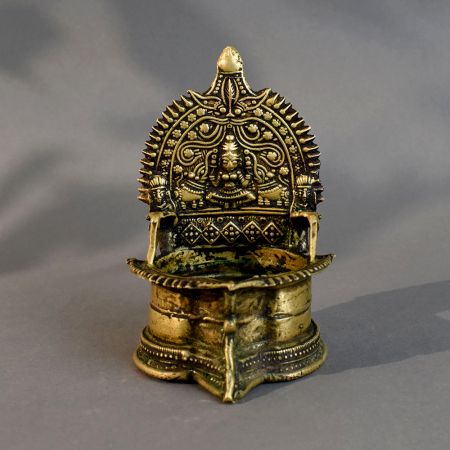-
Traditional Brass South Indian Vintage Handmade Pooja Diya with Goddess Carving
- ₹ 2,100.00
-
Only 1 left
General Understanding of Gajalakshmi Vilakku Oil Lamps
A Gajalakshmi Vilakku lamp doesn’t merely light a space, it centers it. Born from the sacred image of Goddess Lakshmi seated with elephants on either side, this lamp turns every flicker of flame into a prayer. It doesn’t rush. It stays. It watches over the home, quietly. Often made of brass or bronze, it is not decorative but declarative, a symbol that speaks of wealth that flows, care that shelters, and light that lingers. Whether placed on a floor or hung from a ceiling, its presence is less about tradition and more about timeless emotional anchoring.
What Is A Gajalakshmi Vilakku Oil Lamp?
A Gajalakshmi Vilakku Oil Lamp is a traditional lamp that carries the presence of Goddess Lakshmi, the deity of wealth and well-being. She is often seated on a lotus, flanked by elephants, symbols of strength, prosperity, and divine grace. The word “Vilakku” itself means lamp in Tamil or Malayalam, and “Gajalakshmi” refers to this specific form of Lakshmi with elephants. What makes these lamps unique isn’t just their iconography but the feeling they generate, a rootedness, a quiet wealth that doesn't shout. It is worship, protection, heritage, and prayer, all held in the glow of steady flame.
What Emotions Or Themes Do Gajalakshmi Lamps Commonly Portray?
Gajalakshmi lamps are emotional anchors, they speak of arrival, not just of light, but of inner stability. They portray themes of abundance not in excess, but in fullness, a complete presence, like a mother’s lap. There's also maternal protection, gentleness paired with quiet authority. The elephants represent strength that doesn’t dominate, and Lakshmi represents prosperity that nourishes. These lamps hold emotions that are subtle and enduring, warmth, reverence, hope, and care. Every lighting is a personal ritual, and every ritual is a reminder, that home isn’t just walls and corners but intention, grace, and a steady inward gaze.
What Are The Most Recognized Forms Of Gajalakshmi Vilakku Designs?
The forms may vary, but the soul remains constant. The standing floor lamp with an extended pedestal is widely recognized, often used in temple entrances or pooja rooms. Hanging versions, suspended from ceilings, are equally popular in Kerala and Tamil households. Then there’s the back-arched Vilakku, where the entire imagery of Lakshmi and elephants is carved against a crescent or semi-arched frame, giving a sense of visual completeness. Each of these designs adapts to space and mood, whether it’s grandeur or intimacy. But at the heart of all these lies the same gesture, devotion in bronze.
Why Are Gajalakshmi Vilakku Lamps Still Revered In Modern Spaces?
In modern homes, where fast design often lacks depth, Gajalakshmi lamps bring something rare, intention. They offer a spiritual pause in a world that’s constantly moving. Their presence makes a corner feel sacred, no matter how contemporary the architecture. These lamps are not nostalgia. They are grounding. The craftsmanship holds memory, the iconography holds meaning, and the act of lighting it every evening creates routine with soul. In a time when much feels disposable, these lamps refuse to be background objects. They are mood, memory, and meaning, infused with reverence and made for moments that matter.
Craftsmanship, Materials & Artistic Detailing in Gajalakshmi Vilakku Lamps
The artistry behind these lamps is neither loud nor flashy. It is meditative. The Gajalakshmi Vilakku is often made using ancient casting methods, lost wax or sand casting, each process carrying centuries of artisanal tradition. Brass and bronze are not chosen for mere aesthetics but for energy, they last, they shine, they sanctify. Carvings go beyond visuals, every curve, every elephant tusk, every lotus petal is an offering, shaped slowly and with prayer. The detailing is where it breathes, whether placed in a pooja room or entryway, its presence draws attention not by design but by dignity.
How Are Gajalakshmi Vilakku Oil Lamps Traditionally Crafted?
Traditional crafting of Gajalakshmi lamps is a slow, thoughtful process passed down through generations. Artisans begin with wax models, shaping every detail, from Lakshmi’s serene expression to the curve of the elephants’ trunks. Once the wax structure is complete, it is coated with clay and heated to melt the wax, leaving a hollow mold. Molten brass or bronze is then poured in, creating a piece that captures both form and feeling. After cooling, each lamp is hand finished, polished, sometimes engraved, but never rushed. The time taken isn’t just for precision, it’s a gesture of reverence through process.
What Materials Are Commonly Used In Gajalakshmi Lamps?
Brass and bronze are the soul metals of Gajalakshmi lamps. These alloys are not just practical, they are symbolic. Brass reflects clarity and abundance. Bronze adds depth and durability. Copper may also be used at times, particularly for its spiritual conductivity. The choice of metal affects how the lamp ages, both physically and energetically. These materials aren’t chosen to shine temporarily but to last lifetimes, gathering patina, stories, and spiritual charge. The weight of these lamps isn’t just physical, it’s emotional, cultural, and devotional. You don’t just hold a lamp, you hold the memory of many hands.
What Role Does Carving Play In These Lamps?
Carving is not embellishment here, it is prayer in motion. Every detail, from the gentle gaze of Lakshmi to the graceful lift of elephant trunks, carries meaning. It tells a story without words. The lotuses aren’t flowers, they’re metaphors for purity. The arched backs aren’t just curves, they form a halo of divine presence. Carving transforms a block of metal into a living narrative. It is where the artisan and the devotee meet. Precision here is love, not labor. It’s where divinity becomes touchable. In every groove and pattern, you see the soft hands of belief at work.
Spiritual Symbolism and Storytelling of Gajalakshmi Vilakku
There’s a quiet power in the way Gajalakshmi Vilakku holds space in a room calm, steady, sacred. It’s more than brass. It’s a vessel that cradles stories, prayers, and traditions. At the heart of it is Goddess Lakshmi, flanked by elephants, offering a sense of continuity between the material and spiritual. Light is not just illumination it’s presence. When you place this lamp at your door or altar, you invite not only wealth but the essence of home. The form never screams. It hums. It doesn’t need language it rests in energy, in every curve, gesture, and flame it holds upright.
What Stories Or Values Do Gajalakshmi Lamps Aim To Represent?
Gajalakshmi Vilakku embodies a still yet abundant grace. At its core, it speaks of protection, prosperity, and fertility. It honours Goddess Lakshmi, who is often visualized seated on a lotus, with elephants bathing her with divine water, symbolizing continuous abundance. Placing this lamp at thresholds, doorways, pooja rooms, represents a quiet transition from the mundane to the sacred. It is less about idolization and more about alignment. These lamps are often part of family rituals, inheritance, and rites, becoming vessels of memory and transmission. They don’t merely decorate they declare a rootedness in dharma, devotion, and the ever-burning pursuit of light over darkness.
How Do These Lamps Express Religious Or Cultural Beliefs?
Every line, burnish, and curve of the Gajalakshmi Vilakku is intentional. The lamp stands as a convergence point, between ritual and belief, between the divine feminine and earthly sustenance. Its flame is more than fire, it’s a continuation of Vedic yajnas, where light was the carrier of offerings to the gods. The placement of the goddess isn’t accidental, it’s an invocation of energy. The elephants, symbols of rain and power, reinforce prosperity. This lamp doesn’t just illuminate a space it affirms a lifestyle where spiritual practice is woven into the everyday. From temple steps to living rooms, it communicates a living culture.
How Do Shape, Flame, And Symbolism Influence Their Impact?
The shape of a Gajalakshmi Vilakku tells you where to focus, how to feel. The arch encircling the goddess offers a frame, not a cage, a suggestion of infinity. The central figure, never imposing, invites rather than demands. The flame rises in stillness, and with it, the thoughts of those who sit nearby. Its symmetry is not just aesthetic, it’s metaphysical, a balance of forces, an internal harmony reflected outward. The lamp becomes a center of gravity. It calms the room. Its visual alignment keeps rituals grounded and gives clarity to wandering attention. It is not decorative it’s directional.
Purchase, Collection & Investment in Gajalakshmi Vilakku Lamps
Owning a Gajalakshmi Vilakku isn’t just about possession it’s about choosing meaning over material. Whether bought from temple-side artisans or modern curated platforms, what you acquire is an imprint of generations. Each curve reflects a hand’s labour and a community’s belief. When added to a home, it becomes part of its rhythm. For collectors, it’s not about variety it’s about depth. For investors, it’s an heirloom. In every form, compact or ceremonial, it asks you to pause, light a wick, and let memory flow through flame. In a world of noise, this lamp speaks in silence, offering continuity and soul.
Where Can You Buy Authentic Gajalakshmi Lamps Today?
You can find authentic Gajalakshmi Vilakku lamps in specialized decor boutiques, temple-side markets, heritage craft fairs, or trusted online platforms that value tradition over trends. The best pieces often come from regions where the craft is inherited rather than taught, like Kumbakonam or Madurai. These places don’t just sell products, they pass on sacred continuity. Modern interpretations may play with form, but true authenticity lies in weight, posture, balance, and the quietude it radiates. Look for platforms that preserve these values, not dilute them for aesthetic minimalism.
How Can You Identify A Well-Crafted Gajalakshmi Lamp?
A well-crafted Gajalakshmi lamp feels grounded in your palm. It won’t wobble or glare. The goddess's face must have softness, not sharp mechanical lines. The engraving should tell a story, not just mark space. Check for proportion, how the elephants are aligned, how the arch isn’t too steep or shallow. The polish, often antique or oxidized, should not feel like a layer, it should feel like time. True craftsmanship has silence in its detailing. It doesn’t shout excellence, it breathes it. There’s always a difference between a molded piece and a sculpted one, and the Gajalakshmi Vilakku should always feel sculpted.
What Makes Gajalakshmi Vilakku A Valuable Investment?
Its value doesn’t fluctuate like trend-based decor. It deepens. The spiritual symbolism of the Gajalakshmi Vilakku is timeless, which means its worth is never entirely aesthetic or market-driven. Handmade from brass or panchaloha, each lamp carries the weight of both history and intent. These are not fast-made pieces. They hold the slow breath of artisans, the whispers of rituals, and the presence of generations. For someone who believes in heritage, this lamp becomes more than an object, it becomes a family anchor. That is what makes it invaluable not price, but presence.
Maintenance, Placement & Preservation of Gajalakshmi Lamps
The care you give reflects the respect you hold. Gajalakshmi Vilakku lamps don’t demand attention, but they respond to it. A light cloth, some coconut oil, or lemon juice and salt can bring back their lost sheen. But it’s more than maintenance, it’s a ritual. Where you place them matters entrance to invite energy, pooja corners for focus, or center shelves to draw presence. And if an old piece loses shine, it doesn’t lose meaning. Restoration is memory work, reviving, not replacing. These lamps don’t age. They grow into your space like something planted, lit, and loved.
How Do You Care For Gajalakshmi Vilakku Lamps At Home?
Begin with dry cloth dusting, often. Let the metal breathe. For deeper cleaning, use a soft cloth with gentle brass cleanser or traditional homemade solutions like tamarind pulp or lemon-salt. Avoid harsh detergents, they corrode memory, not just metal. Once cleaned, oil the wick-holder occasionally to avoid dryness. Store unused lamps in cotton or muslin. Treat it like a being, not a thing. Because in many homes, it is the presence, a quiet observer of life’s turning wheels. The more you care, the more it stays, not just in form, but in feeling.
What Placement Enhances Their Purpose And Presence?
Place it where breath slows. Near the entrance, it becomes a guardian, inviting wealth and grounding energy. In pooja rooms, it amplifies silence. On a center shelf, it anchors the space. But always place it slightly elevated, never directly on the ground. The wick should face east or north, towards beginnings and clarity. Never crowd it with decoration. Let it be what it is, central, visible, open. And wherever you place it, light it with intent. This lamp doesn’t just brighten corners it brings continuity between the visible and the remembered, the ritual and the real.
Can Older Lamps Be Restored Or Repolished?
Absolutely. Restoration doesn’t erase it reveals. A skilled restorer knows how to retain the patina of age while softening signs of neglect. The key lies in understanding what not to remove the fine engravings, the wear from decades of touch, the dents that narrate history. Brass or bronze Gajalakshmi lamps can be soaked, brushed gently, and treated with natural polishers. Some restorers use herbal mixtures or essential oils to preserve both shine and scent. When restored right, an old lamp doesn’t look new it looks remembered. And that makes all the difference.
What Are Common Issues In Lamp Care Over Time?
Over years, you’ll notice tarnish creeping in, especially if the lamp is rarely cleaned. Soot buildup around the wick-holder is common, especially if lit frequently. Oil spills can harden and gather dust if not wiped regularly. But none of these are permanent problems. They're part of its lived life. Regular cleaning, monthly polishing, and wiping off soot after every use will keep the lamp glowing. If it dulls, it doesn’t die it waits. Lamps like these don’t fade they pause, asking you to return, touch, clean, and remember.
Home Decor, Mood & Interior Styling With Gajalakshmi Lamps
Gajalakshmi lamps don't scream for attention, yet they hold it. Placed in a corner, on a mantle, or by an entrance, they silently infuse the room with reverence. Their form is sacred, their presence assured. Unlike generic décor, they aren’t passive, they witness. The brass gleam softens with time, giving not decay but dignity. In homes that blend memory with modernity, these lamps find purpose. Whether beside a boho throw or against a terracotta wall, they create a visual anchor. The light they emit isn't just warm, it feels known, lived-in. In a world of fleeting accents, Gajalakshmi lamps stay.
How Do These Lamps Affect The Mood Of A Space?
These lamps act like emotional architects within a space. Their light isn't flashy, it’s steady, like a breath that doesn't falter. This stability has psychological effects, it slows the room down. People speak a little softer, sit a little longer. The carved elephants flanking Lakshmi aren’t just symbolic, they subconsciously echo strength, prosperity, and protection. Their mere presence instills calm and a quiet sense of ceremony. At night, the flame is more than illumination, it’s a return to self. In spiritual corners or reading nooks, this lamp becomes a mood-setter, not just for ambiance but for energy. It doesn’t demand worship, but it evokes mindfulness. A reminder, perhaps, that space is sacred when we choose to treat it so. More than a light source, it is a spiritual anchor, subtle yet transformative.
What Interior Styles Welcome Gajalakshmi Vilakku Lamps?
These lamps are more versatile than most assume. In rustic homes, they nestle naturally among exposed woods and handloom weaves. In minimalist homes, a single Gajalakshmi lamp becomes the focal point, breaking the monotony of sterile whites with spiritual gold. Contemporary-traditional interiors welcome them as bridges, where memory meets modernity. In boho settings, the brass lamp adds weight, offering a cultural pause amidst playful colors and layered fabrics. These lamps don’t compete, they coexist. What they offer is grounding. Whether placed against clay walls in a Tamil home or in a Scandinavian-styled Mumbai flat, they adapt without losing their purpose. The key isn’t matching the lamp to the home, it’s letting it hold its space without distraction. It carries a presence that allows even the most modern interiors to feel inherited.
How Do You Choose The Right Size For A Room?
Scale isn't just about size, it’s about intimacy. A compact Gajalakshmi lamp fits perfectly on a puja shelf, study table, or beside a reading chair. Its presence is felt, not flaunted. For temple corners, living room floors, or near house entrances, larger floor-standing variants or hanging pieces make a gentle statement. The taller versions feel ceremonial, ideal for festive or prayer spaces. The hanging ones draw the eye upward, creating vertical awareness and spatial clarity, ideal for homes with high ceilings or open verandahs. Before choosing a size, feel the room. Is the room calm or cluttered? High or grounded? Lamps placed too large in tiny corners feel theatrical, while those too small in vast spaces seem lost. Let the lamp echo the room's energy, matching its breath, not just its furniture. A lamp should speak in proportion, not overpower.
Cultural Legacy & Community Relevance of Gajalakshmi Vilakku
They’re not just décor, they’re memory, myth, and motion. Gajalakshmi lamps carry the lore of protection, fertility, and divine abundance. Passed down in ceremonies and housed in ancestral altars, they carry soil-bound stories and sky-bound prayers. They aren’t just lit, they’re awakened. From grandmother’s rituals to modern home sanctuaries, they evolve yet endure. Their relevance isn’t nostalgia, it’s a living continuity. They're not locked in temples, they're lived in homes, rituals, and seasonal changes. Each lamp becomes a touchpoint, between family, region, and spiritual rhythm. In a world where mass production strips meaning, these lamps remain soulful, made by hands, not machines.
What Is The Cultural Significance Behind Gajalakshmi Lamps?
Gajalakshmi Vilakku lamps are more than objects, they are embodiments of the goddess Lakshmi in her most revered form, flanked by elephants, symbolising wealth, protection, and auspicious beginnings. Lighting one is akin to inviting that grace into the home. These lamps trace their origins to temple architecture, where they served as both spiritual and ceremonial fixtures. Over time, they travelled from sanctums into households, especially during festivals like Diwali or Varalakshmi Vratham. But the essence remains, invoking balance between material abundance and spiritual anchoring. Unlike decorative lamps, Gajalakshmi lamps are loaded with intent. They signify the act of continuity, between generations, between mortals and the divine, between craft and devotion. Even in modern homes, when lit with reverence, they don’t just glow, they participate. They remind us that prosperity isn’t just economic, it’s emotional, cultural, and ritualistic.
How Do Different Regions Interpret This Lamp Style?
Though unified by goddess Lakshmi, Gajalakshmi lamps reflect local hands and heritage. In Tamil Nadu, they're deeply ornate, often shaped in tiered structures and used during Karthigai Deepam. Kerala’s versions feel earthier, sometimes cast with softer curves, reflecting temple architecture and Ayurvedic philosophies of balance. Odisha lends its own twist, thinner silhouettes, intricate carvings, and a blend of tribal patterns. Each region treats the lamp not just as function but as form, rhythm, and story. Regional festivals also influence when and how these lamps are lit. Some are purely symbolic, others are central to rituals. The differences don’t dilute the meaning, they deepen it. They allow the lamp to evolve while retaining its soul. What binds them is not just religion, but the human impulse to preserve sanctity and light in daily life, through regional dialects of craftsmanship and faith.
Which Artisans Preserve This Tradition Today?
In small bylanes of Kumbakonam, in the workshops near Thrissur, and in seasonal haats across Odisha, families still mold, cast, and chisel Gajalakshmi lamps by hand. These are not industrial outputs, they’re heritage acts. Most of these artisans have no digital footprint. Their knowledge isn’t documented, it’s sung, shown, repeated. Sons watch fathers. Daughters join mothers during festivals to finish detailing. Some belong to temple families entrusted with making lamps as ritual obligations. Others sell during fairs like Pushkar or temple utsavs. But they all carry something machines can’t replicate, intention. When you buy a lamp from them, you’re not buying a product, you’re investing in a living craft. They fight against imitation brassware sold in bulk. Every curve they carve is a resistance, to forgetting, to apathy, to erasure. Supporting them means keeping history lit, not just homes.
Comparison With Other Sacred Decor Elements
Other sacred decor holds presence, but Gajalakshmi lamps carry participation. Diyas flicker, candles melt, but these lamps stand guard. They embody belief and beckon memory. They are deity, design, and devotion in one frame. Where others offer mood, these offer meaning. They're not just placed, they’re placed with purpose.
How Are Gajalakshmi Lamps Different From Diyas Or Candles?
The difference lies in intent. Diyas are beautiful, often clay-based, seasonal, and symbolic, but they’re fleeting. Candles, whether fragrant or tapered, are primarily atmospheric, set for moments. Gajalakshmi lamps, in contrast, are enduring presences. They are not lit casually. Their very form, a seated Lakshmi flanked by elephants, holds layered spiritual codes. They are not just tools of light but objects of reverence. While diyas evoke warmth during festivals, and candles lend romance or reflection, Gajalakshmi lamps demand a relationship. You clean them, adorn them, speak to them. They are often lit with ghee or sesame oil, invoking not just brightness but healing. They don’t burn out in an hour, they glow through prayers. In function, they may all offer light, but in experience, only Gajalakshmi lamps offer sanctity. They aren’t momentary accessories, they are sacred companions.
What Sets Them Apart From Modern Brass Decor Pieces?
Most modern brass decor serves aesthetic goals, sleek lines, mirror-polished curves, and mass replicability. They are visually striking but spiritually hollow. Gajalakshmi lamps, on the other hand, hold history. They are devotional artefacts, shaped with scriptural context and generational knowledge. Modern brassware is made to match interiors, Gajalakshmi lamps are made to invoke emotion. Their presence is not dictated by trend but by tradition. Where modern décor is silent, these lamps speak, they carry stories, blessings, even obligations. They are cleaned on certain moon days, lit during specific hours, adorned with flowers or turmeric. This ceremonial life gives them a presence beyond materiality. They are not meant to blend in, they are meant to belong. They do not fade with fads. Instead, they deepen with time, becoming heirlooms rather than just home accents.
How Do Floor Lamps Differ From Hanging Gajalakshmi Lamps?
The placement alters the impact. Floor-standing Gajalakshmi lamps are grounding, both symbolically and visually. They draw the energy downward, stabilizing a space. Ideal for entrances or room corners, they serve as spiritual anchors. When lit, the glow hugs the floor and slowly rises, evoking the imagery of light emerging from within the earth. Hanging lamps, on the other hand, reverse this dynamic. Suspended from a ceiling hook or beam, they evoke ascent. Their presence draws the eyes and thoughts upward. They're often seen in verandahs, above altars, or temple ceilings, connecting earthly living with celestial seeking. The hanging format also mirrors temple traditions where the divine is believed to descend. In essence, floor lamps root you. Hanging ones lift you. Both carry Gajalakshmi’s presence, but their moods differ, one calms, the other elevates. Choose based on what your space and spirit longs for.
Symbolic & Emotional Value of Gajalakshmi Vilakku
A Gajalakshmi Vilakku is more than just a lamp. It’s an emblem of presence. The flame doesn’t merely light up a corner, it ignites intention. Lakshmi, flanked by elephants, stands tall as prosperity’s guardian, but what makes the lamp sacred is not just the form, it’s the act of lighting it. A daily ritual. A silent prayer. A moment of inward return. Over time, the lamp becomes a keeper of memories, burning softly in the background of childhood mornings, festival eves, and elder blessings. It symbolizes continuity in a world that changes too fast. Anchored in bronze, elevated by belief.
Can These Lamps Be Gifted For Special Occasions?
Absolutely. A Gajalakshmi Vilakku isn’t just a gift, it’s a blessing shaped in metal and meaning. Housewarmings invite new beginnings, and what better gesture than offering a light believed to attract wealth and peace? Weddings, where two lives merge, find in the lamp a reminder of shared light, how two individuals will now protect a shared flame. During festivals like Diwali or Navratri, gifting this lamp reconnects us with the sacred in a tangible form. It’s not about decor. It’s about intention. You don’t just give an object, you gift a future memory, a ritual, a whisper of home.
What Sentimental Worth Can A Family Lamp Hold?
Every flicker of a family’s Gajalakshmi lamp tells a quiet story. The hands that lit it before you, your mother’s, her mother’s, become part of its memory. The oil stains on the base, the softened edges of once-sharp carvings, all bear witness to the passage of time. It's a legacy, not of wealth, but of care. It gets lit in joy, in worry, in silent prayers at dusk. When passed down, it isn’t just a lamp, it becomes a bridge between generations. It holds what photographs often fail to capture, presence, warmth, the scent of rituals, and the comfort of continuity.
Why Do People Feel Spiritually Drawn To These Lamps?
The pull isn’t towards the object, it’s towards the presence it evokes. When you light a Gajalakshmi Vilakku, something shifts. The space quiets. You feel seen. The goddess isn’t just a symbol, she’s a listener. Her elephants, her calm smile, the slow rise of heat from the flame, all of it nudges you inward. In a world of noise, the lamp offers stillness. The act of lighting it becomes meditation. You’re not just igniting a wick, you’re calling in grace, drawing boundaries of safety and abundance. That’s why people return to it, not out of habit, but out of need.
Frequently Asked Questions (FAQs)
What Defines A Gajalakshmi Vilakku Lamp?
It’s a traditional oil lamp, usually made of brass or bronze, showcasing the goddess Lakshmi seated with elephants on either side, symbols of prosperity and strength. Whether small enough to sit on a puja shelf or tall enough to command a corner of a room, what defines it is this central motif of the divine, flanked by guardians, grounding the idea of wealth in devotion and light.
Can Gajalakshmi Lamps Be Reproduced Authentically Today?
Yes, and with remarkable fidelity. There are clusters of artisans, especially in Tamil Nadu and Kerala, who still follow age-old casting methods. The molds, materials, and even rituals around crafting them have stayed intact, though many now include modern finishes for easier upkeep. These lamps don’t just replicate the past, they preserve it through touch, flame, and form.
How Do You Protect These Lamps From Tarnish Or Oxidation?
Brass and bronze are both reactive metals, but care is simple. Store the lamp in a dry space and avoid prolonged contact with water. Use mild, non-abrasive metal polish once a month or when tarnish appears. Silica gel packs inside storage boxes help absorb moisture. Also, lighting it regularly and wiping with a soft cloth maintains its sheen and spirit, use keeps it alive, both materially and symbolically.
Are Gajalakshmi Vilakku Lamps Still Relevant In Modern Homes?
Completely. In fact, they carry a dual charm now, spiritual and aesthetic. Amid concrete and chaos, this lamp becomes a grounding element. Whether on a console table or beside a minimalist altar, it invites calm and culture into contemporary life. It offers not just light, but meaning, a gentle reminder of one’s roots, values, and inner rituals in a world rushing forward.
Can The Gajalakshmi Style Be Adapted In Modern Designs?
Absolutely. Designers today often adapt the essence of the lamp, Lakshmi’s silhouette, the elephant motifs, into sleeker forms. Wall-mounted versions, pendant lights with the same aura, even simplified metallic contours that carry the energy without heavy detail. These hybrids speak to modern sensibilities while retaining the cultural spirit. The lamp, thus, evolves, but never loses its soul.
